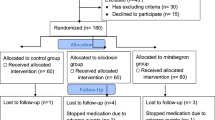Abstract
To show the efficacy of mirabegron for medical expulsive treatment, in patients had intramural located distal ureteral stone. A 80 patients had intramural ureteral stone were assessed retrospectively between April 2017 and January 2018. Mirabegron 50 mg/day + diclofenac 100 mg/day (group 1, n = 40), and only diclofenac 100 mg/day (group 2, n = 40) were administered to patients, consecutively. Age, gender, stone size, laterality, and severity of hydronephrosis were recorded. Spontaneous stone expulsion rates (SER), stone expulsion time, and the number of daily colic episodes were evaluated. In the group 1, one (2.5%) patient was excluded due to nasopharyngitis, and one (2.5%) patient was excluded due to 5 mmHg systolic blood pressure increase. In addition, four (10%) patients in group 1, and six (15%) patients in group 2, who did not attend follow-up examinations, were excluded from the study. There was not any statistically significant difference between the two groups in terms of age, gender, stone location, severity of hydronephrosis, stone size (p = 0.736, p = 0.310, p = 0.467, p = 0.801, p = 0.761, consecutively). Spontaneous expulsion ratios were calculated as 73.52% in group 1, and 47.05% in group 2 (p = 0.026). However, there was not any statistically significant difference in terms of stone expulsion time (p = 0.979). SER for patients had ≤ 6 mm stones was higher in group 1 (87.5 vs 52.49%, p = 0.031). In addition, group 2 patients had more pain episodes (1.02 ± 0.52 vs. 1.29 ± 0.57, p = 0.049). In the current study, mirabegron has been shown to be an efficient, safe and a new treatment modality, with lower side effect profile for the intramural located distal ureteral stones.

Similar content being viewed by others
References
Pearle MS, Lotan Y (2012) Urinary lithiasis: etiology, epidemiology, and pathogenesis. In: Wein AJ, Kavoussi LR, Novick AC, Partin AW, Peters CA (eds) Campbell-Walsh urology, 10th edn. Saunders Elsevier, Philadelphia, pp 1257–1286
Segura JW, Preminger GM, Assimos DG, Dretler SP, Kahn RI, Lingeman JE et al (1997) Ureteral stones clinical guidelines panel summary report on the management of ureteral calculi. Am Urol Assoc J Urol 158:1915–1921
Dellabella M, Milanese G, Muzzonigro G (2003) Efficacy of tamsulosin in the medical management of juxtavesical ureteral stones. J Urol 170:2202–2205
Teichman JM (2004) Clinical practice: acute renal colic from ureteral calculus. N Engl J Med 350:684–693
Hollingsworth JM, Rogers MA, Kaufman SR et al (2006) Medical therapy to facilitate urinary stone passage: a meta-analysis. Lancet 368:1171–1179
Singh A, Alter HJ, Littlepage A (2007) A systematic review of medical therapy to facilitate passage of ureteral calculi. Ann Emerg Med 50:552–563
Beach MA, Mauro LS (2006) Pharmacologic expulsive treatment of ureteral calculi. Ann Pharmacother 40:1361–1368
Mozafarpour S, Hernandez N, Lipkin M, Eisner BH (2016) Outcomes of ureteroscopy. Minerva Urol Nefrol 68:560–569
Kılınç MF, Doluoğlu ÖG, Karakan T et al (2016) The effect of ureteroscope size in the treatment of ureteral stone: 15-year experience of an endoscopist. Turk J Urol 42:64–69. https://doi.org/10.5152/tud.2016.84594
Galli R, Sighinolfi MC, Micali S, Martorana E, Rosa M, Mofferdin A, Bianchi G (2017) Advantages of the supine transgluteal approach for distal ureteral stone extracorporeal shock wave lithotripsy: outcomes based on CT characteristics. Minerva Urol Nefrol 6:189–194
Erturhan S, Erbagci A, Yagci F, Celik M, Solakhan M, Sarica K (2007) Comparative evaluation of efficacy of use of tamsulosin and/or tolterodine for medical treatment of distal ureteral stones. Urology 69(4):633–636
Matsumoto R, Otsuka A, Suzuki T et al (2013) Expression and functional role of b3-adrenoceptors in the human ureter. Int J Urol 20:1007–1014
Tomiyama Y, Murakami M, Hayakawa K et al (2003) Pharmacological profile of KUL-7211, a selective b-adrenoceptor agonist, in isolated ureteral smooth muscle. J Pharmacol Sci 92:411–419
Shen H, Chen Z, Mokhtar AD, Bi X, Wu G, Gong S, Huang C, Li S, Du S (2017) Expression of β-adrenergic receptor subtypes in human normal and dilated ureter. Int Urol Nephrol Oct 49(10):1771–1778
Park Y-C, Tomiyama Y, Hayakawa K et al (2000) Existence of a b3-adrenoceptor and its functional role in the human ureter. J Urol 164:1364–1370
Bierkens AF, Hendrikx AJM, De La Rosette JJMCH et al (1998) Treatment of mid- and lower ureteric calculi: extracorporeal shock-wave lithotripsy vs laser ureteroscopy. A comparison of costs, morbidity and effectiveness. BJU Int 81:31–35
Douglas Stephens F (1964) Intramural ureter and ureterocele. Postgrad Med J 40:179–183 11
Igawa Y, Michel MC (2013) Pharmacological profile of b3-adrenoceptor agonists inclinical development for the treatment of overactive bladder syndrome. Naunyn Schmiedebergs Arch Pharmacol 386:177–183
Tomiyama Y, Murakami M, Akiyama K et al (2002) Modification of ureteral motility and promotion of urine flow around an intraureteral obstruction by CL-316243, phenylephrine, and furosemide in dogs. Neurourol Urodyn 21:251–257
Chapple C, Wyndaele JJ, van Kerrebroeck P et al (2010) Dose-ranging study of once-daily mirabegron (YM178), a novel selective b3-adrenoceptor agonist, in patients with overactive bladder (OAB). Eur Urol Suppl 9:249
Nitti V, Herschorn S, Auerbach S et al (2011) The efficacy and safety of mirabegron in patients with overactive bladder syndrome—results from a North-American Phase III trial. Eur Urol Suppl 10:278
Funding
There was no funding.
Author information
Authors and Affiliations
Corresponding author
Ethics declarations
Conflict of interest
Mehmet Solakhan, Omer Bayrak and Ersan Bulut each declare no potential conflicts of interest.
Human and animal rights and informed consent
This article does not contain any studies with human or animal subjects performed by any of the authors.
Rights and permissions
About this article
Cite this article
Solakhan, M., Bayrak, O. & Bulut, E. Efficacy of mirabegron in medical expulsive therapy. Urolithiasis 47, 303–307 (2019). https://doi.org/10.1007/s00240-018-1075-5
Received:
Accepted:
Published:
Issue Date:
DOI: https://doi.org/10.1007/s00240-018-1075-5




